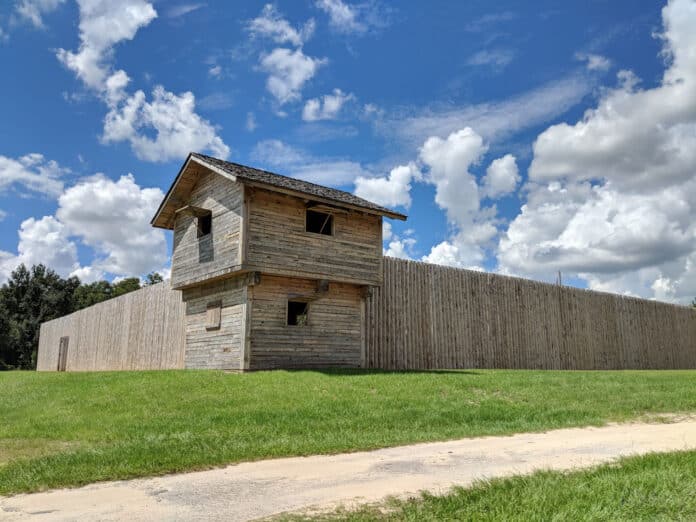Two of the better known Seminole War forts were Fort Brooke in Tampa and Fort King in Ocala.
Major Francis Langhorne Dade and 110 men were marching from Fort Brooke to Fort King when they were massacred. It was Dade’s third time leading troops from Fort Brooke to Fort King.
Fort Brooke was located in what is now downtown Tampa near the Amalie Arena. The Fort is no longer there although there is a Cotanchobee Fort Brooke Park. The park also holds the Tampa Bay History Center. There are plaques with a version of the history of the Seminole Wars and earlier Indians. There is also a Fort Brooke parking garage nearby.
The plaque in the park says:
“When the U.S. acquired Florida, in 1821, the policy of the US government still favored making treaties & attempting to buy Indian lands. Within a decade, however the situation changed dramatically Gen Andrew Jackson became President Jackson. The Indian Removal Act (1830) made it official policy that any future treaties would require the Natives to move to the newly created “Indian Territory” west of the Mississippi River. The situation of the Florida Indians already had been worsened significantly by the Treaty of Moultrie Creek (1823), which restricted them to poor, wet, & unproductive lands in the center of the peninsula. The military authorities tried to restrict liquor dealers from the reservation, but with little suce cess Some settlers, desirous of Indian lands & the economic upturn that a military presence would bring, disguised themselves as Indians & attacked their own neighbors in order to justify a call for a military buildup. Promised supplies did not arrive on time; the Indians planting & harvesting cycles were disrupted; & starvation became a real possibility. The Treaty of Payne’s Landing (on the St. John’s River), forced upon the Florida Indians in 1832, was strictly a Removal treaty. The determination of the U.S. government to enforce this treaty would precipitate the longest & most costly Indian war in US history. The entire fighting system of the U.S. Army, Navy, & Marine Corps would change because of the experiences of the soldiers at Fort Brooke & other Florida forts during the Seminole Wars of Removal”
Fort King has been rebuilt- at least the outer wall and some of the internal rooms. The reconstruction was unveiled Dec. 2, 2017. The fort is constructed of split logs and is located on a hill. It is an impressive reconstruction and brings history alive. The fort covers a large area and you can picture buildings and tents in the interior.
From the plaque at Fort King:
“Here stood Fort King, the ‘King of Forts’ in frontier Florida. It was constructed during the summer of 1827 by two companies of soldiers under Captain James M. Glassell. Built of native long leaf pines, the picket fort was typical of U.S. Army frontier forts built to keep the peace between American pioneers and Native Americans.
While under siege by local Seminole Indians, the fort was abandoned by the U.S. Army in May 1836 and subsequently burned to the ground by the Seminoles. It was reconstructed by the Army one year later in the summer of 1837.
Serving as southern headquarters for the U.S. Army during the Second Seminole War, it was decommissioned in 1843 and used as the first courthouse of Marion County. By 1846 it was dismantled and used to construct private homes.”
Imagine for a minute walking from downtown Tampa to Ocala, while wearing a soldier’s uniform. Long pants and a long sleeve shirt would protect you from the mosquitos, but it would be unbearably hot. This was before mosquito spraying. A part of this area you marched through was called Mosquito County, so you would be thankful for the protection of the clothes.
The path the soldiers traveled was more of a faint trail. The last ill fated march that Major Dade made on the trail had not been traveled in awhile, since it was believed that only large parties of soldiers would be safe.
Although Fort Brooke and Fort King were the major forts of that era, Hernando had three Second Seminole War forts: Fort Cross, Fort Annutteliga, Fort De Soto and a Third Seminole War fort: Fort Taylor.
We do not have any signs to denote where these forts were located. Long time residents remember both Fort Cross and Fort De Soto having signs that marked where they were located. Those signs are gone and the knowledge of where they were is fading.
It is important to preserve our history. Signs could be placed where these forts once stood or as they did in Ocala, a replica could be built of the original fort. Another option would be to follow Tampa’s example and create a park where the fort once stood.

